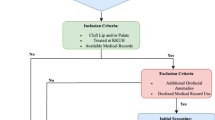Abstract
Background
This study reviews the 15 year program of our Department of Pediatric Surgery for the treatment and follow-up of children born with a cleft in Benin and Togo.
Methods
We analyzed files of children born in Africa with a cleft. They were referred to us through a nongovernmental organization (NGO) between 1993 and 2008 and assessed in Africa by local pediatricians before and after surgery. Operations were performed by our team.
Results
Two hundred files were reviewed: 60 cases of unilateral cleft lip, seven of bilateral cleft lip, 44 of unilateral cleft lip palate (UCLP), 29 of bilateral cleft lip palate (BCLP), 53 of cleft palate (CP), three of bilateral oro-ocular cleft, one of unilateral and two of median clefts (Binder), and one of commissural cleft. Sixty-nine (35 %) of these cases were not operated in Africa: 25 (12.5 %) had not shown up, 28 (15 %) were considered unfit for surgery (Down’s syndrome, HIV-positive, malnutrition, cardiac malformation), and 16 (7.5 %) were transferred to Switzerland. Palatal fistula occurred in 20 % of UCLP, 30 % of BCLP, and 16 % of CP. Evaluation of speech after palate surgery gave less than 50 % of socially acceptable speech.
Conclusions
Our partnership with a NGO and a local team makes it possible to treat and subsequently follow children born with a cleft in West Africa. Surgery is performed under good conditions. If aesthetic results are a success, functional results after palate surgery need further improvement to promote integration in school and social life.





Similar content being viewed by others
References
Malek R (2000) Cleft and lip palate. Lesionsm pathophysiology and primary treatment. Martin Dunitz, London
Borel-Maisonny S (1975) L’insuffisance vélaire, point de vue de l’orthophoniste. Reeduc Orthophon 13:61–81
Mossey PA, Shaw WC, Munger EG et al (2011) Global oral health inequalities: challenges in the prevention and management of orofacial clefts and potential solutions. Adv Dent Res 23:247–258
Alkire B, Hughes CD, Nash K et al (2011) Potential economic benefit of cleft lip and palate repair in sub-Saharian Africa. World J Surg 35:1194–1201. doi:10.1007/s00268-011-1055-1
Yazdy M, Honeim M, Rasmussen S et al (2007) Priorities for future public health research in orofacial clefts. Cleft Palate Craniofac J 44:251–357
Dupuis Ch (2004) Humanitarian missions in the third world: a polite dissent. Plastic Reconstr Surg 113:433–435
White EB (2006) Volunteerism and humanitarian efforts in surgery. Curr Probl Surg 43:848–929
Saboye J (1999) Plastic surgery training missions in developing countries. A 10-year experience at missions in Mali. Ann Chir Esthet 44:35–40
McWilliams BJ, Morris HL, Shelton RJ (1990) Cleft palate speech. BC Decker, Philadelphia
Lohmander-Agerskov A, Havstam C, Söderpalm E et al (1993) Assessment of speech in children after repair of isolated cleft palate. Scand J Plast Reconstr Surg Hand Surg 27:307–310
Shprintzen RJ (1989) Evaluation of velopharyngeal insufficiency. Otolaryngol Clin North Am 22:519–536
de Buys Roessingh AS, Cherpillod J, Trichet C, Hohlfeld J (2006) A comparison of the effect of a cranial-based pharyngeal flap on the speech of children born with a total cleft, an isolated cleft palate or a short palate. J Oral Maxillo Surg 12:1736–1742
Agrawal K, Panda K (2011) A modified surgical schedule for primary management of cleft lip and palate in developing countries. Cleft Palate Craniofac J 48:1–8
McPherson DI, Jerger J (1971) Impedance audiometry. Arch Otolaryngol 93:338–340
Acknowledgment
The authors are grateful to Annette Wagnière for reviewing the English text.
Conflict of interest
All authors have no financial or relationships with other people or organizations that could inappropriately influence their work. There is no grant support for this research.
Ethical standard
Ethical approval given by the Faculty of Medicine of the University of Lausanne, Switzerland.
Author information
Authors and Affiliations
Corresponding author
Rights and permissions
About this article
Cite this article
de Buys Roessingh, A.S., Dolci, M., Zbinden-Trichet, C. et al. Success and Failure for Children Born with Facial Clefts in Africa: A 15-Year Follow-up. World J Surg 36, 1963–1969 (2012). https://doi.org/10.1007/s00268-012-1607-z
Published:
Issue Date:
DOI: https://doi.org/10.1007/s00268-012-1607-z



